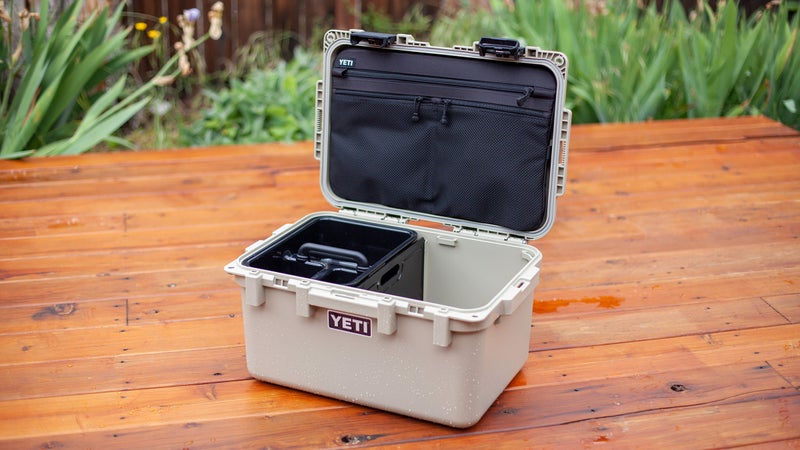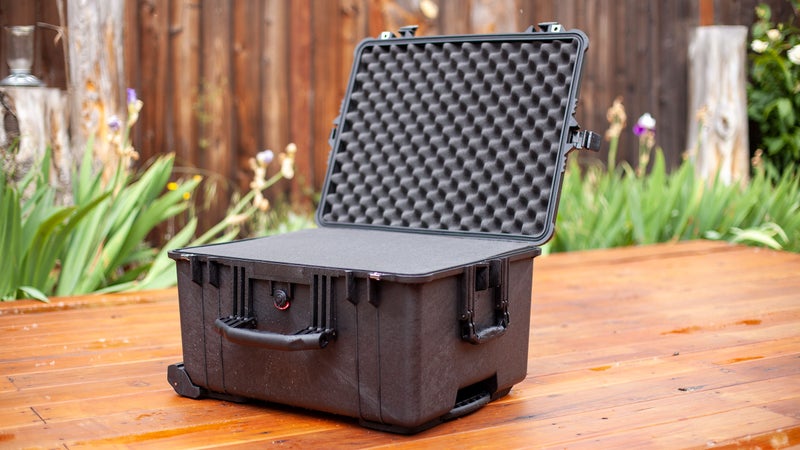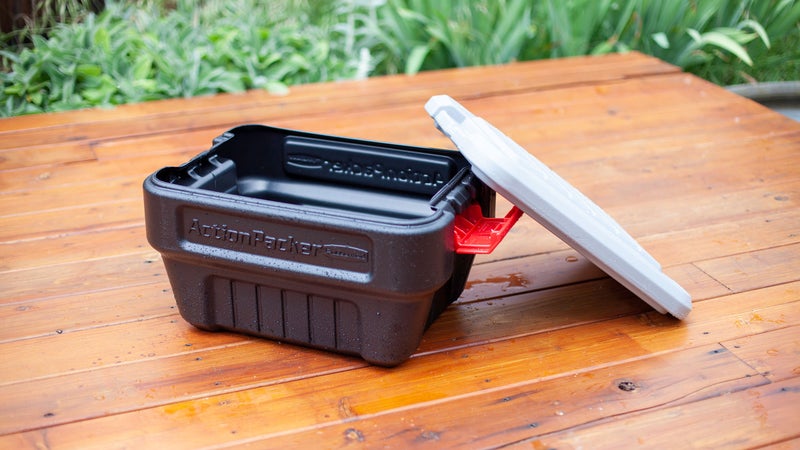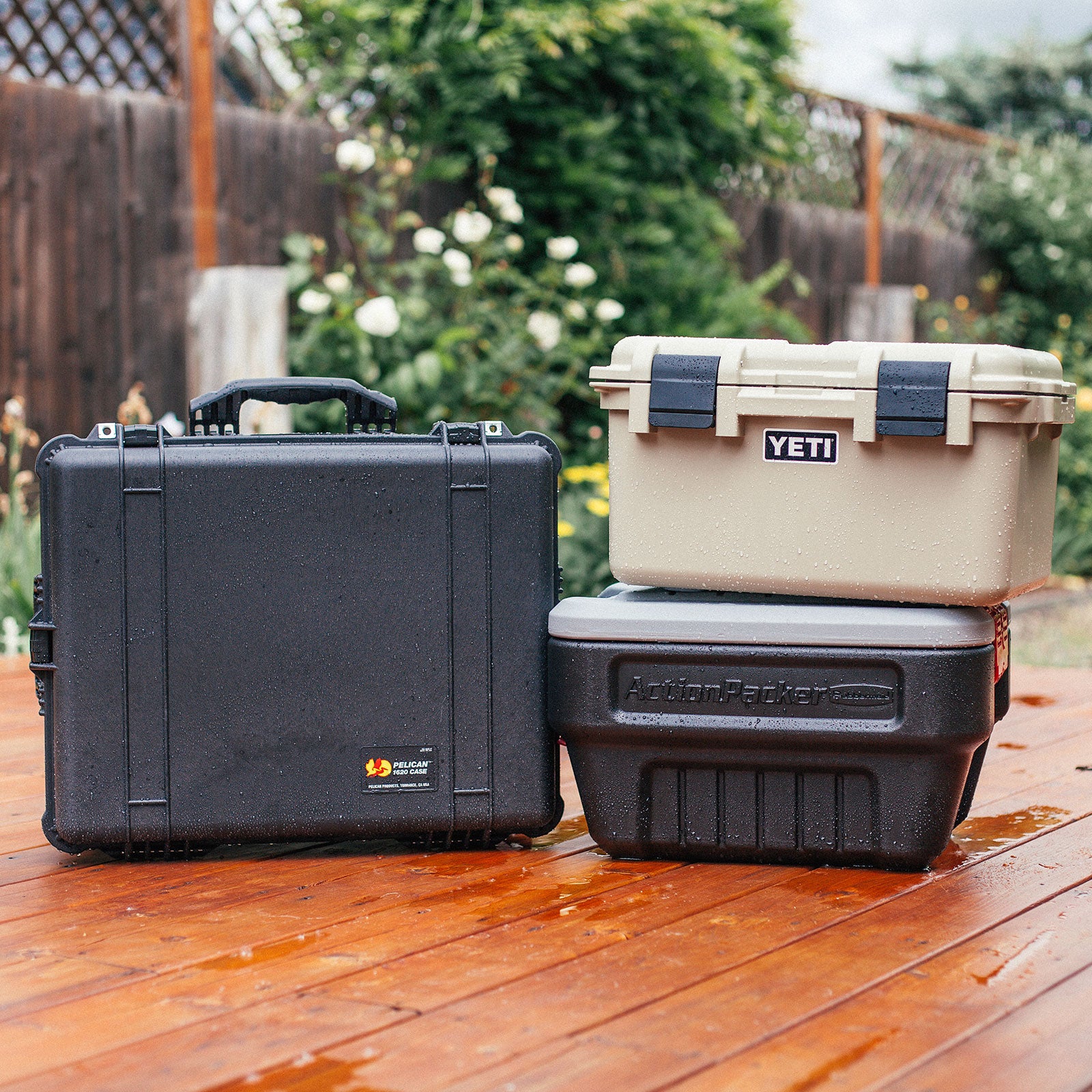A few weeks ago, YetiÔÇÖs new $250 LoadOut GoBox 30 went on sale. As with pretty much every debut from the Austin, Texas, brand known for making expensive and burly coolers, packs, and drinkware, the multipurpose cargo box looked incredibly durable. So naturally┬áI wanted to beat the snot out of it to see just how it holds upÔÇöand if itÔÇÖs worth that price tag.
I pitted the LoadOut GoBox in a head-to-head-to-head test with the closest equivalents from Pelican (which is more expensive) and Rubbermaid (which is less than an eighth of the price). I gauged their durability, flotation, waterproofing, organization, portability, and how well each kept its contents safe.
The Contenders
($250)

($275)

($30)

The Tests
Flotation
I put ten pounds of weightÔÇöin the form of individual one-pound pods from the Harbinger weight vest I use during workoutsÔÇöin each and threw them in my Jacuzzi to see if they floated. I settled on ten pounds because itÔÇÖs a good average weight for the amount of gear youÔÇÖd be carrying in these, whether itÔÇÖs in the form of camera equipment or a camp kitchen.
The Winner: Three-way tie. All of them floated.
Weatherproofing
I weighed three cotton shirts and placed one in each bin. Then┬áwith my garden hose on the jet setting, I blasted the boxes from two feet away, spraying along the seam of each side exactly 100 times (400 sprays in total for each model). I was trying to re-create splashing like theyÔÇÖd encounter on a raft or in the rain. Then I used the shirts to mop up any moisture that had gotten inside and weighed them again.
The Winner: This was a tie between Yeti and PelicanÔÇöboth were bone dry, as they should be, since both are advertised as being waterproof. There was a small sprinkling of water inside the Rubbermaid bin, but it was still impressively minimal at only one gram of water.
Organization
I took my camp kitchenÔÇöconsisting of utensils, a spatula, paper towels, knives, a corkscrew, soap, a sponge, hand sanitizer, a lighter, a small pot and pan, cooking oils and spices, two plates, and two tumblersÔÇöand packed it into each of these bins three times.
The Winner: YetiÔÇÖs LoadOut GoBox, which comes with a removable plastic tray (called the Caddy), a center divider, and three pockets inside the lid. This system was easy to pack and unpack, which made finding gear easy and was an absolute dream for this anal-retentive camper. I loved that all the pieces of my kitchen could have their own easy-access place. The mesh pockets were especially handy for storing smaller items like spices (and pilfered Taco Bell Fire Sauce packets) and my lighterÔÇöwhich I appreciated, knowing how frustrating it is to find those little items┬áat the bottom of a packed bin. The Pelican and Rubbermaid only have a┬ásingle large compartmentÔÇöfine for fitting everything but without the organization of the LoadOut. ItÔÇÖs worth noting that you can use smaller bins and place them inside the larger main compartments to keep gear separate, though that isnÔÇÖt as tidy or secure as the LoadOutÔÇÖs standard system.
Portability
I put my 31-pound kettlebell in each of the containers and carried them around my yard four times, roughly an eighth of a mile.
The Winner: Pelican. Both the LoadOut and Action Packer lack substantial handles (theyÔÇÖre essentially just small indentations), so the load was a little unwieldy and my fingers got sore. But not with the Pelican. It has sturdy top and side handles┬áplus small wheels for rolling, and it was a breeze to carry with one hand. That said, the minimalist Yeti and Rubbermaid handles are less likely to break in the field. (More on the durability of PelicanÔÇÖs handles later.)
Protection
I placed a raw egg in each of the cases and created a pendulum with an eight-pound maul attached to a metal clothesline in my backyard. Then I lifted the maul up to my waist and let it swing into the cases five times, checking after each impact to see if the egg broke.
The Winner: Pelican. The Rubbermaid egg didnÔÇÖt survive the first swing. The other two cases performed admirablyÔÇöthe eggs were safe in the top pocket of the Yeti and the interior foam of the Pelican, respectively, and went back into my fridge without any cracks. I gave the win to the Pelican Protector, though, because of that foam. Called Pick N Pluck, itÔÇÖs gridded cushioning with little squares that you can pull out to form customized depressed pockets for your gearÔÇögood for keeping delicate items safe. The Pelican is the only product I would trust with my DSLR.
Durability
After the egg test, I used the same maul pendulum to hit every side of the containers five more times. I also hit every latch and handle five times. Then I took the same kettlebell from the portability test and dropped it on the top and bottom of each container five more times from chest height.
The Winner: Another tie between Pelican and Yeti. Both were barely dinged after the pendulum test. I was particularly impressed that the PelicanÔÇÖs two handles were fine after five direct hits. And the Protector was so strong that it sent the kettlebell bouncing two feet into the air (forcing me to jump aside to avoid crushing a toe), and the Yeti just shrugged off the weight. While that impressive rebound made me want to favor the Pelican, both showed equal wear and tear: about a centimeter-deep dent on the top and nothing but faint kettlebell stamps on the bottom.
That said, I was blown away by how well the Rubbermaid Action Packer handled the pendulum barrage. Though it was a little scarred, the latches remained in perfect working order. Sadly, it succumbed to its injuries on the third kettlebell drop to its lid when a three-inch crack formed above one of the handles, compromising the waterproofing and making it hard to snap shut.
The Takeaway
I set out to answer two questions with this review: Which is the best container, and is the Yeti LoadOut worth the money?
The answer to number one is (sorry): it depends. Clearly the Yeti and Pelican products are amazing, but they proved to be excellent options for different users. I would absolutely buy the Protector if I were planning to travel with multiple expensive cameras and lenses. And the LoadOut is a great addition to a rafting kit and perfectly fits a familyÔÇÖs camp kitchen.
Regarding number two, I do believe the GoBox is worth the money. In the decade I spent as a rafting guide, I saw too much gear crushed by people stepping or sitting on it, not to mention plenty of phones dropped in the water. And if the waterproof GoBox saves your $1,000 iPhone X from the drink, itÔÇÖs just paid for itself four times over. Plus, it performed comparably to the more expensive model from PelicanÔÇöa brand thatÔÇÖs proven it knows how to make a high-end cargo box.


